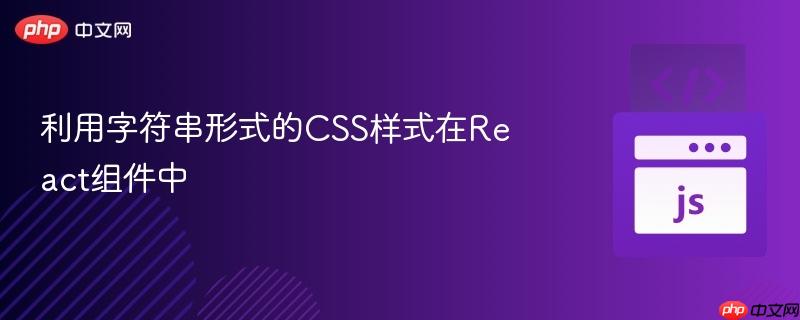
本文探讨了在React组件中有效使用字符串格式CSS样式的多种策略。针对无法直接应用CSS字符串的问题,我们介绍了通过CSS解析与选择器前缀化、利用Web Components的Shadow DOM实现样式隔离,以及将内容渲染到iframe中以获得完全隔离等方法。文章旨在提供专业且实用的教程,帮助开发者根据具体需求选择最合适的解决方案。
在React开发中,我们有时会遇到需要将外部获取的、以字符串形式存在的CSS样式应用到组件中的场景。直接将这些CSS字符串作为style属性或className属性的值是无效的,因为React的style属性期望一个JS对象,而className则期望一个类名字符串。本文将详细介绍几种处理这种情况的专业方法,帮助开发者有效管理和应用这些动态样式。
这种方法的核心思想是解析原始CSS字符串,为其中的每个选择器添加一个唯一的、组件特定的前缀,然后将修改后的CSS注入到文档的<head>部分。这样可以确保样式仅作用于目标组件及其子元素,避免全局污染。
实现步骤:
立即学习“前端免费学习笔记(深入)”;
示例代码(概念性):
import React, { useEffect, useId, useState } from 'react';
// 假设有一个CSS解析和前缀化工具函数
// import { parseAndPrefixCss } from './utils/cssProcessor';
function DynamicStyledComponent({ cssString, children }) {
const componentId = useId(); // 生成一个唯一的ID,例如 ":r0:"
const [scopedCss, setScopedCss] = useState('');
useEffect(() => {
if (cssString) {
// 这是一个概念性函数,实际需要引入CSS解析库并实现
// 例如:const processedCss = parseAndPrefixCss(cssString, `[data-id="${componentId}"]`);
// 为了演示,我们手动模拟一个简单的前缀化
const prefixedCss = cssString.replace(/(\.[a-zA-Z0-9_-]+)/g, `[data-id="${componentId}"] $1`);
setScopedCss(prefixedCss);
}
}, [cssString, componentId]);
// 使用useEffect将样式注入到head
useEffect(() => {
if (scopedCss) {
const styleTag = document.createElement('style');
styleTag.setAttribute('data-scope-id', componentId);
styleTag.textContent = scopedCss;
document.head.appendChild(styleTag);
return () => {
// 组件卸载时移除样式
document.head.removeChild(styleTag);
};
}
}, [scopedCss, componentId]);
return (
<div data-id={componentId}>
{children}
</div>
);
}
// 使用示例
const myCss = `.some-class { color: red; } .another-class { font-size: 16px; }`;
function App() {
return (
<div>
<h1>My App</h1>
<DynamicStyledComponent cssString={myCss}>
<p className="some-class">This text should be red.</p>
<span className="another-class">This text should be 16px.</span>
</DynamicStyledComponent>
<p className="some-class">This text should NOT be red (unaffected by scoped style).</p>
</div>
);
}注意事项:
Web Components提供了一种原生的方式来封装HTML、CSS和JavaScript。其中,Shadow DOM是实现样式隔离的关键特性。通过将组件内容渲染到Shadow DOM中,其内部的样式将自动作用域化,不会泄漏到外部,外部样式也不会轻易影响到内部。
实现步骤:
立即学习“前端免费学习笔记(深入)”;
示例代码:
import React, { useRef, useEffect } from 'react';
import ReactDOM from 'react-dom/client'; // 使用React 18的createRoot
function ShadowDomHost({ cssString, children }) {
const hostRef = useRef(null);
const shadowRootRef = useRef(null);
const reactRootRef = useRef(null); // 用于存储React Root
useEffect(() => {
if (hostRef.current && !shadowRootRef.current) {
// 附加Shadow DOM
const shadowRoot = hostRef.current.attachShadow({ mode: 'open' });
shadowRootRef.current = shadowRoot;
// 创建一个容器用于React渲染
const reactContainer = document.createElement('div');
shadowRoot.appendChild(reactContainer);
// 创建React Root并渲染子组件
const root = ReactDOM.createRoot(reactContainer);
reactRootRef.current = root;
root.render(children);
// 插入样式
if (cssString) {
const styleTag = document.createElement('style');
styleTag.textContent = cssString;
shadowRoot.prepend(styleTag); // 将样式插入到内容之前
}
} else if (reactRootRef.current) {
// 如果Shadow DOM已存在,仅更新React内容
reactRootRef.current.render(children);
}
}, [children, cssString]);
// 组件卸载时清理
useEffect(() => {
return () => {
if (reactRootRef.current) {
reactRootRef.current.unmount();
reactRootRef.current = null;
}
shadowRootRef.current = null;
};
}, []);
return <div ref={hostRef} />;
}
// 使用示例
const myShadowCss = `.shadow-class { background-color: lightblue; padding: 20px; } p { color: darkgreen; }`;
function AppWithShadow() {
return (
<div>
<h2>Content Outside Shadow DOM</h2>
<p className="shadow-class">This paragraph is outside and should not be styled by shadow CSS.</p>
<ShadowDomHost cssString={myShadowCss}>
<div className="shadow-class">
<h3>Content Inside Shadow DOM</h3>
<p>This paragraph is inside and should be dark green.</p>
<span style={{ color: 'red' }}>Inline styles still work.</span>
</div>
</ShadowDomHost>
<h2>More Content Outside Shadow DOM</h2>
</div>
);
}注意事项:
将HTML内容和CSS样式渲染到一个<iframe>中是实现样式完全隔离的最简单直接的方法。Iframe创建了一个独立的浏览上下文,其内部的样式和脚本不会影响到外部文档,反之亦然。
实现步骤:
立即学习“前端免费学习笔记(深入)”;
示例代码:
import React, { useRef, useEffect } from 'react';
function IframeRenderer({ htmlContent, cssString }) {
const iframeRef = useRef(null);
useEffect(() => {
if (iframeRef.current) {
const iframe = iframeRef.current;
const doc = iframe.contentDocument || iframe.contentWindow.document;
// 清空旧内容
doc.open();
doc.write(''); // 清空iframe
doc.close();
// 写入新的HTML和CSS
doc.open();
doc.write(`
<!DOCTYPE html>
<html>
<head>
<style>${cssString}</style>
</head>
<body>
${htmlContent}
</body>
</html>
`);
doc.close();
}
}, [htmlContent, cssString]);
return (
<iframe
ref={iframeRef}
style={{ width: '100%', height: '300px', border: '1px solid #ccc' }}
title="Dynamic Content"
/>
);
}
// 使用示例
const dynamicHtml = `
<div class="container">
<h1>Hello from Iframe!</h1>
<p class="text-style">This text is styled by iframe's CSS.</p>
<button>Click me</button>
</div>
`;
const iframeCss = `
.container {
font-family: Arial, sans-serif;
padding: 15px;
background-color: #f0f0f0;
border-radius: 8px;
}
.text-style {
color: #333;
font-size: 18px;
margin-bottom: 10px;
}
button {
background-color: #007bff;
color: white;
padding: 8px 15px;
border: none;
border-radius: 4px;
cursor: pointer;
}
`;
function AppWithIframe() {
return (
<div>
<h2>Content Outside Iframe</h2>
<p style={{ color: 'blue' }}>This text is blue and outside the iframe.</p>
<IframeRenderer htmlContent={dynamicHtml} cssString={iframeCss} />
<h2>More Content Outside Iframe</h2>
</div>
);
}注意事项:
处理React组件中的字符串格式CSS样式,没有一劳永逸的解决方案,最佳选择取决于具体的应用场景和需求:
不建议的方法是尝试解析CSS并手动将其转换为内联样式应用到DOM元素上,因为这种方法无法支持伪类、伪元素和媒体查询等复杂的CSS特性,且维护起来极其困难。开发者应根据项目的具体需求,权衡上述方法的优缺点,选择最适合的策略。
以上就是利用字符串形式的CSS样式在React组件中的详细内容,更多请关注php中文网其它相关文章!

每个人都需要一台速度更快、更稳定的 PC。随着时间的推移,垃圾文件、旧注册表数据和不必要的后台进程会占用资源并降低性能。幸运的是,许多工具可以让 Windows 保持平稳运行。

Copyright 2014-2025 https://www.php.cn/ All Rights Reserved | php.cn | 湘ICP备2023035733号